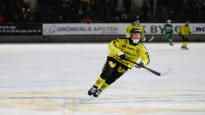STOCKHOLM. After four hours of driving, the bus turns into the parking lot of Stockholm’s traditional Zinkensdamm sports field. Vetlanda’s iceball team descends from the car, accompanied by the Finns Topi Peuhkuri and Emil Fedorov. The third Finn in the team, Santtu Nurmihas stayed home to be sick.
Vetlanda’s trio is part of the mass migration of Finnish hockey players to Swedish ice. This year 18 went west and three came back. In total, more than 40 Finns play in Sweden’s top leagues.
For goalkeeper Topi Peuhkur, moving to the west is a dream come true. In Vetlanda, familiar Finns and big brother were waiting Eetu Peuhkuri had played in the team before.
– Mainly because of the circumstances, I came, and this is a much tougher league than the Finnish Bandy League. This was the right place to come and measure the skills, Peuhkuri says.
Emil Fedorov is already playing in Vetlanda for the fifth season. The goal was to get to the toughest league, and that can be found in Sweden. In the horizontal cup, the consistency of the series also weighed. All teams can beat each other.
Ice ball, bandy in Swedish, is in great demand. You can see it, for example, at the Zinkensdamm ticket gate. 1,966 tickets will be sold for Saturday’s game. The stand is full of the host team Hammarby’s green and white and there is a bit of Vetlanda’s yellow and black.
Almost 20 years of experience in building ice ball rinks in Sweden
At the Finnish Ice Hockey Association’s office in Helsinki’s Pitäjänmäki, we are facing a big question: Are there enough players left for the domestic leagues, because there are so many people leaving?
– It’s not that we don’t understand these players. In Sweden, you get a completely new opportunity to develop as an individual in hockey. But here there is a risk that it will tarnish our series and in the long run also the Swedish series, executive director Tobias Karlsson says.
A large number of Finns also take playing spots from Swedish juniors. According to Karlsson, there have been discussions with Swedish colleagues in a good spirit about foreigner quotas for the Swedish league, but the matter has not progressed.
Compared to Finland, the Swedish iceball league has a big advantage: there are 19 iceball rinks. The number will increase even more in the near future, as six rinks are generating revenue. There are not even the first halls in Finland yet. There have been plans, but they have expired.
– Halls are completely decisive. The opportunities for playing ice hockey are completely different, the ice is much longer, Director of Sports of the Swedish Ice Hockey Association Karin Törneklint says.
In Sweden, you can get to big ice 8–9 months a year, in Finland 3–4 months.
The first hall in Sweden was already built in 2003. Lessons have been accumulated along the way and the new halls are more energy efficient than ever.
– Build halls. They are the future of ice hockey, but they also give children and young people a chance to skate if the winters are bad. But build smart. Come to Sweden and follow the example of how we have done it, encourages Törneklint.
Törneklint hopes for a boost to the Finnish and also Norwegian ice ball leagues. Because of its war, Russia has kicked itself out of the ice ball family, and therefore there is more demand for international cooperation than ever.
You can’t get rich playing ice ball in Sweden either
Iceball is not the way to riches in Sweden either. Topi Peuhkuri says that there is no need to dream of “NHL mansions” and many people do part-time work. Remote work was arranged for Peuhkur from a staffing company.
Emil Fedorov started at Vetlanda soon after moving to work in a kindergarten and works more than 20 hours a week.
– I have enjoyed. I like interacting with people and moving around with children.
The flow to Sweden is unlikely to stop in the next few years. The pain of Finnish hockey is compounded by the fact that the number of junior hockey players has dwindled. There are only a few dozen players in each of the oldest junior age groups in the whole country.
– I throw the responsibility on the association and the teams to do better junior work, market the sport better and build a sharper brand, says Peuhkuri.
It can be difficult if ice hockey in Finland continues on outdoor ice.
